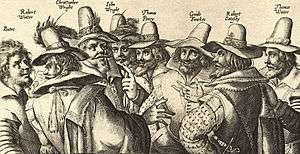Capotain
This article is about the hat associated with Puritan costume. For the hat used by pilgrims on the Way of St. James, see Pilgrim's hat.

Woman in a Capotain by Nicholas Hilliard, 1602
A capotain, capatain or copotain is a tall-crowned, narrow-brimmed, slightly conical "sugarloaf" hat, usually black, worn by men and women from the 1590s into the mid-seventeenth century in England and northwestern Europe. Earlier capotains had rounded crowns; later, the crown was flat at the top.
The capotain is especially associated with Puritan costume in England in the years leading up to the English Civil War and during the years of the Commonwealth. It is also commonly called a Flat Topped Hat and a Pilgrim hat, the latter for its association with the Pilgrims that settled Plymouth Colony in the 1620s. Contrary to popular myth, capotains never included buckles on the front of them; this image was created in the 19th century.[1]
Gallery
 England, 1592
England, 1592 England, 1600s
England, 1600s Holland, 1615
Holland, 1615 Flanders, 1630s
Flanders, 1630s England, 1640s
England, 1640s
Further reading
- Ashelford, Jane: The Art of Dress: Clothing and Society 1500–1914, Abrams, 1996. ISBN 0-8109-6317-5
- Arnold, Janet: Patterns of Fashion: the cut and construction of clothes for men and women 1560–1620, Macmillan 1985. Revised edition 1986. (ISBN 0-89676-083-9)
- Black, J. Anderson and Madge Garland: A History of Fashion, Morrow, 1975. ISBN 0-688-02893-4
See also
| Wikimedia Commons has media related to Capotain. |
References
- ↑ 17th century hats Archived October 16, 2006, at the Wayback Machine.
This article is issued from Wikipedia - version of the 11/19/2016. The text is available under the Creative Commons Attribution/Share Alike but additional terms may apply for the media files.